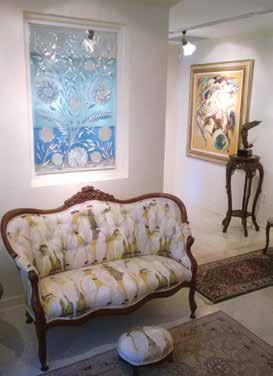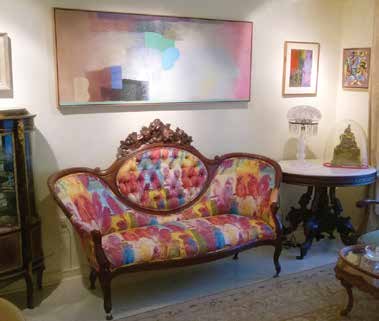ASK THE ARTSPERTS – PASSING ON ART

Another Victorian love seat with Hunt Slonem upholstery, a cut glass window from 1906 and a Jon Corbino oil of “Dancing Horses” from 1962.
by Juliana Meek and Kristine Meek
Dear Artsperts:
My parents loved collecting art and they passed their love of art on to me and my brothers, but when my parents passed away recently, my siblings and I had a horrible time sorting out who should get what paintings and sculpture.
Do you have any advice?
Signed,
Inherited Headache
Dear Inherited,
In most instances folks are usually describing works of art which either filled the decorative needs in a home or were part of a real interest in collecting art. In the latter case, works were placed wherever they might fit regardless of decorating concerns. Major collectors who have so much art that it must be stored offsite or may be on long term loan to various museums most likely already have a plan in place to donate the collection to a non-profit museum, library, or university.
We will focus on the first group of modest collectors.

An example of our own parents’ collection: Hunt Slonem upholstered Victorian sofa; Robert Natkin, Jimmy
Ernst & Byron Browne paintings; a Pairpoint cut glass lamp and French brass lamp.
Parents often listen through the years to find out which works of art are cherished by which children and may already name those
works specifically in their wills. Sometimes parents will place tags on the back of paintings or under bases of sculpture noting a child or grandchild’s name. We have heard stories of jealous siblings sneaking around to change the tags to suit their own desires!
In many cases the furnishings and art are often just left for the children to divide after the parents have passed away. That can either become an amicable situation or a testy one at best. You can try to estimate value or have the works appraised, but sometimes something of less monetary value has great sentimental value. The remaining works which have no interest to any of the children can be taken to an auction house, brought to the gallery the work was purchased to be consigned, or donated.
Works of art can go up or down in value relative to when they were originally purchased.
Tastes change and popularity of a particular artist and demand versus availability of their works can change as well. While they were in your parent’s home(s) they represented the tastes of your parents and brought your parents enjoyment.
In your collecting, keep receipts of what works you purchased – for how much and where from – and look for free auction appraisal events at area auction houses to have an idea what your art might sell for at auction. You should also check with your CPA or tax advisor about any federal or state inheritance tax implications.
Sincerely,
The Artsperts



Leave a Reply
Want to join the discussion?Feel free to contribute!